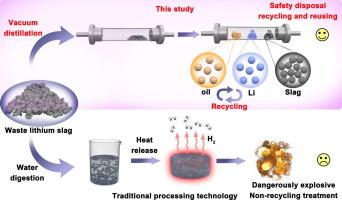Extracting metallic lithium and separating diffusion pump oil from lithium slag using a novel negative pressure distillation technology
IF 8.1
1区 工程技术
Q1 ENGINEERING, CHEMICAL
引用次数: 0
Abstract
Lithium slag, an industrial by-product derived from oil refining systems during the extraction of metallic lithium via molten salt electrolysis, holds a substantial concentration of lithium metal, thus positioning it as a valuable secondary resource. However, disposal poses significant challenges due to the highly reactive nature of the oil and metallic lithium it contains. To address this, a dual-stage vacuum distillation method was employed to ensure safe handling. The process utilized distinct volatilization and condensation properties of the slag components. First, vacuum pump oil was distilled and recovered at a temperature of 300 °C under a pressure of 10 Pa. Second, at 700 °C, metallic lithium was volatilized and subsequently collected on a condenser. This approach achieved effective separation and recovery of valuable elements. Infrared spectra analysis of the oil extracted from lithium slag before and after distillation revealed significant similarity, thereby validating its successful recycling and reuse. Additionally, the collected metallic lithium achieved a purity level of ˃ 98 %. Computational analysis using Fluent software accurately predicted the condensation temperature and metallic lithium volume as well as oil under low-pressure and high-temperature conditions, thereby correlating with experimental results. Subsequent industrial-scale experiments conducted at a 5 kg level demonstrated the efficient and clean recovery of both metallic lithium and oil.


求助全文
约1分钟内获得全文
求助全文
来源期刊

Separation and Purification Technology
工程技术-工程:化工
CiteScore
14.00
自引率
12.80%
发文量
2347
审稿时长
43 days
期刊介绍:
Separation and Purification Technology is a premier journal committed to sharing innovative methods for separation and purification in chemical and environmental engineering, encompassing both homogeneous solutions and heterogeneous mixtures. Our scope includes the separation and/or purification of liquids, vapors, and gases, as well as carbon capture and separation techniques. However, it's important to note that methods solely intended for analytical purposes are not within the scope of the journal. Additionally, disciplines such as soil science, polymer science, and metallurgy fall outside the purview of Separation and Purification Technology. Join us in advancing the field of separation and purification methods for sustainable solutions in chemical and environmental engineering.
 求助内容:
求助内容: 应助结果提醒方式:
应助结果提醒方式:


